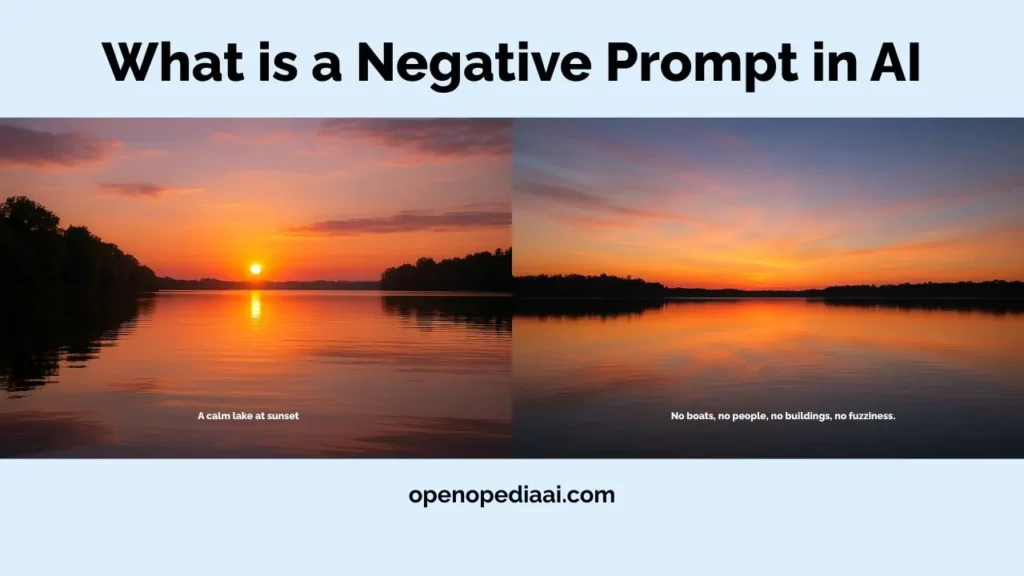Generative AI has made it much easier for people to create images, stories, videos, and more just by typing a few words.
But to get the perfect result, it’s not enough to only say what you want. You also need to say what you don’t want. That’s where negative prompts come in.
In this article, we’ll explain what negative prompts are, how they work, where they’re used, and why they’re important especially in AI tools like Stable Diffusion and DALL·E that turn text into images.
What is a Negative Prompt?
A negative prompt tells an AI what not to include in its output, like a filter for things you don’t want. Regular prompts say what you do want, but negative prompts help avoid unwanted stuff.
For example:
- Regular Prompt: “A calm lake at sunset.”

- Negative Prompt: “No boats, no people, no buildings, no fuzziness.”

This helps the AI create a cleaner, more focused result by steering clear of common issues or things it might add by mistake.
How do Negative Prompts Work?
Negative prompts work by telling the AI what to leave out when it makes something for you. Normally, the AI tries to guess what you want based on what you ask for (like “a pretty forest”).
But sometimes it adds stuff you don’t want like blurry lines or extra objects because of how it was trained.
When you add a negative prompt (like “no cars, no clouds”), you’re giving the AI a list of things to avoid. It then focuses harder on what you do want and skips those unwanted bits.
Think of it like saying, “Draw a dog, but don’t make it purple or tiny.” It helps the AI stay on track and gives you a better result.
Create a picture of a quiet desert at night.
- Positive Prompt: “A peaceful desert under a starry sky.”
- This tells the AI what you want: a desert, nighttime, and stars.
- Negative Prompt: “No people, no cars, no buildings, no blurry edges.”
- This tells the AI what to avoid: crowds, vehicles, houses, or messy details.
- Result: The AI makes an image of a calm, empty desert with clear stars, skipping anything busy or fuzzy.
This workflow helps you get exactly what you’re imagining by guiding the AI with both “do this” and “don’t do that” instructions.
Applications of Negative Prompts
Negative prompts are useful in many ways to make AI outputs better and more specific. Here are some simple examples of how they’re used:
- Cleaner Art: When creating digital art, negative prompts like “no extra arms, no blurry lines” help avoid weird mistakes, making the image look polished and professional.
- Focused Designs: For designing things like logos or products, you might use “no text, no bright colors” to keep the design simple and match your vision.
- Realistic Photos: When generating photo-like images, negative prompts such as “no cartoon style, no odd lighting” ensure the result looks natural, not fake or strange.
- Avoiding Clutter: In scenes like a forest or city, you can use “no crowds, no trash” to keep the image calm and uncluttered, focusing on what matters.
- Fixing Bias: If an AI keeps adding stereotypes (like always showing people in certain jobs), negative prompts like “no uniforms, no clichés” can help make the output more neutral.
Negative prompts act like a guide to steer the AI away from unwanted stuff, giving you results that are closer to what you want.
Benefits and Challenges
Negative prompts have big benefits: they give you more control over AI outputs, help remove unwanted details, and make results cleaner and more accurate. For example, you can avoid messy or off-topic elements easily.
But there are challenges too: picking the right negative words can be tricky, and if you overdo it (like “no this, no that, no everything”), the AI might get confused or produce something too plain. It’s a balance between guiding the AI and letting it still create something useful.
Best Practices for Using Negative Prompts
- Be Specific: Use clear words like “no blurry edges” or “no extra people” instead of vague ones like “no bad stuff.” This helps the AI understand exactly what to avoid.
- Keep It Short: List only the main things you don’t want, like “no cars, no bright lights.” Too many negatives can confuse the AI or make the result too empty.
- Match the Goal: Pair the negative prompt with your positive prompt. For example, if you want “a quiet beach,” use “no crowds, no boats” to fit that vibe.
- Test and Adjust: Try your prompt, see what the AI makes, and tweak it. If something weird still shows up (like odd colors), add it to the negative list, like “no purple sky.”
- Avoid Overdoing It: Don’t block too much (like “no shadows, no details”), or the output might look flat or boring. Let the AI have some room to work.
These steps help you guide the AI smoothly, getting results that look just right without extra hassle.
Conclusion
Negative prompts are a big step forward in how we use AI to create things. They give us more power to shape the results.
By learning how they work and where they’re useful, we can make our ideas come to life better, avoid unwanted results, and explore new ways to create with AI.
As AI gets better, negative prompts will too, making them a key part of how we create with technology.
Submit Your Tool
#1 Best and Most Affordable AI Tools DirectoryDevelopers and advertisers can share their AI tools on Openopediaai AI to reach a bigger audience. By listing your tool with us, you’ll get more visibility and help more people discover your product. You’ll also support the growth of the AI industry by making powerful tools easier for everyone to find and use!






